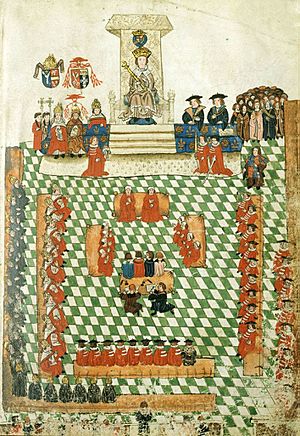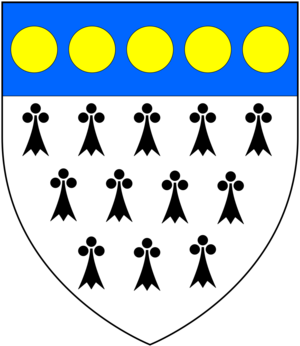William Weston (prior) facts for kids

Sir William Weston (born around 1470 – died May 7, 1540) was a very important knight. He was the last leader, called the Prior, of the Knights of St. John in England. This was during the time of King Henry VIII. As the Prior, he was considered the most important baron in the country. He was known for supporting the Pope. You can still see his tomb today in the crypt of the Priory Church of St. John in Middlesex, which is now part of central London. This church used to be the main home for the Knights of St. John.
Contents
Who Was Sir William Weston?
William Weston was born around 1470. He was the second son of Edmund Weston from Boston, Lincolnshire. His mother was Catherine Camell. William's older brother was Sir Richard Weston (1465–1541). Richard was a close friend of King Henry VIII and a diplomat. He worked as the Governor of Guernsey and the Treasurer of Calais.
Weston Family's Connection to the Knights
The Weston family had strong ties to the Knights of St. John. William's uncle, Sir John Weston, was the Lord Prior of England from 1476 to 1489. Two other uncles held a special role called "Turcopolier". This job was usually given to the bravest knights from England. One of these uncles was probably the William Weston who helped defend Rhodes from the Turks in 1480.
Sir William Weston's Journey as a Knight
In 1498, William Weston was given charge of a place called Ansty Preceptory in Wiltshire. Later, in 1507, he took over Baddesley Preceptory in Hampshire. In 1508, he went to Calais for a special mission.
Defending Rhodes and Becoming Turcopolier
By 1510, Weston was on the island of Rhodes. In 1522, he showed great bravery during a long attack on Rhodes. He was one of the few English knights who survived the battle, and he was even wounded. After leaving Rhodes, the knights went to Crete. In early 1523, Weston was made "Turcopolier" because the previous one had died in battle. He also took command of a large ship called the Great Carrack. This ship was special because it was "the first iron-clad recorded in history." It was covered in metal to protect it from cannons and could hold 500 men.
Becoming the Lord Prior of England
Also in 1523, the English knights agreed that Weston should become the next Prior of England and Ireland. In 1524, he was sent to King Henry VIII to represent the Order. On June 27, 1527, after the death of the previous Prior, Thomas Docwra, William Weston was officially made Lord Prior of England. This was done with a special document from the Grand Master of the Order.
The Lord Prior lived at Clerkenwell Priory in London. This position meant he was the most important baron in England. There was a small problem with his appointment at first. King Henry VIII reportedly wanted to choose his own favorite for the job. He also thought about separating the English knights from the rest of the Order. But the Grand Master, Philippe Villiers de L'Isle-Adam, visited the King. After their meeting, King Henry agreed to Weston's appointment. He also dropped his demand for a yearly payment from the new Prior. In 1535, Weston attended a fancy party hosted by the French ambassador.
Sir William Weston's Final Days
Sir William Weston passed away on May 7, 1540. This was the very same day that the King officially closed down the Order of St. John in England. It is said that he collapsed when he heard the news. However, he had been in poor health for at least a year before that. He was supposed to receive a very large pension of £1,000 a year for the rest of his life. Sadly, he did not live long enough to enjoy it.
Where Sir William Weston Was Buried
He was buried on the north side of the church of the Nunnery of St. Mary Clerkenwell. This church later became St James's Church, Clerkenwell. His tomb had a statue of him lying down, described as "the most artificially cut in stone that ever man beheld." In 1788, the church was rebuilt, and his monument was taken apart. But the statue itself was saved. In 1931, it was moved to its current home in the crypt of St. John's church. This church is the historic Priory Church of the Order of St. John.
See also
- List of the priors of St John of Jerusalem in England


